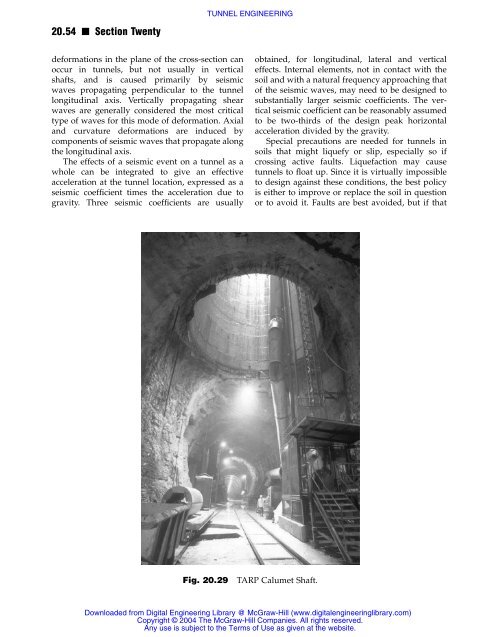TUNNEL ENGINEERING
TUNNEL ENGINEERING
TUNNEL ENGINEERING
You also want an ePaper? Increase the reach of your titles
YUMPU automatically turns print PDFs into web optimized ePapers that Google loves.
20.54 n Section Twenty<br />
deformations in the plane of the cross-section can<br />
occur in tunnels, but not usually in vertical<br />
shafts, and is caused primarily by seismic<br />
waves propagating perpendicular to the tunnel<br />
longitudinal axis. Vertically propagating shear<br />
waves are generally considered the most critical<br />
type of waves for this mode of deformation. Axial<br />
and curvature deformations are induced by<br />
components of seismic waves that propagate along<br />
the longitudinal axis.<br />
The effects of a seismic event on a tunnel as a<br />
whole can be integrated to give an effective<br />
acceleration at the tunnel location, expressed as a<br />
seismic coefficient times the acceleration due to<br />
gravity. Three seismic coefficients are usually<br />
<strong>TUNNEL</strong> <strong>ENGINEERING</strong><br />
Fig. 20.29 TARP Calumet Shaft.<br />
obtained, for longitudinal, lateral and vertical<br />
effects. Internal elements, not in contact with the<br />
soil and with a natural frequency approaching that<br />
of the seismic waves, may need to be designed to<br />
substantially larger seismic coefficients. The vertical<br />
seismic coefficient can be reasonably assumed<br />
to be two-thirds of the design peak horizontal<br />
acceleration divided by the gravity.<br />
Special precautions are needed for tunnels in<br />
soils that might liquefy or slip, especially so if<br />
crossing active faults. Liquefaction may cause<br />
tunnels to float up. Since it is virtually impossible<br />
to design against these conditions, the best policy<br />
is either to improve or replace the soil in question<br />
or to avoid it. Faults are best avoided, but if that<br />
Downloaded from Digital Engineering Library @ McGraw-Hill (www.digitalengineeringlibrary.com)<br />
Copyright © 2004 The McGraw-Hill Companies. All rights reserved.<br />
Any use is subject to the Terms of Use as given at the website.
















